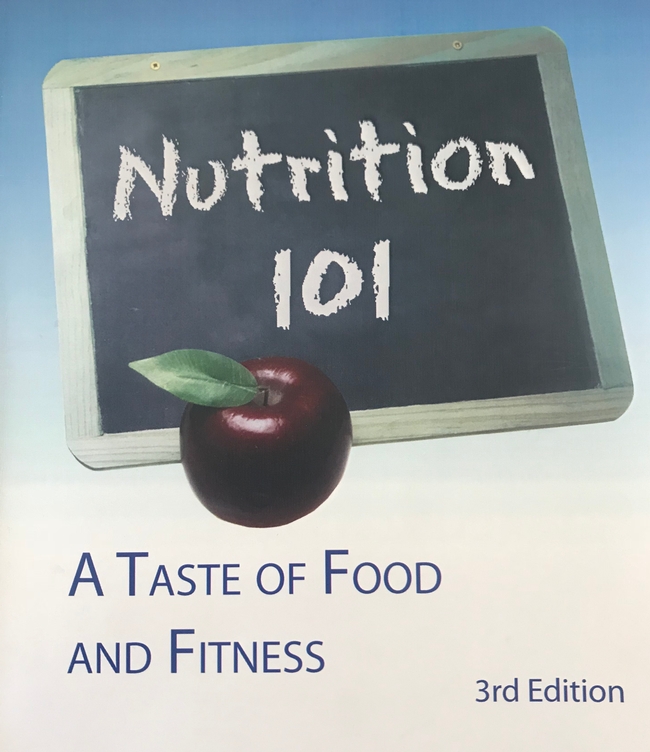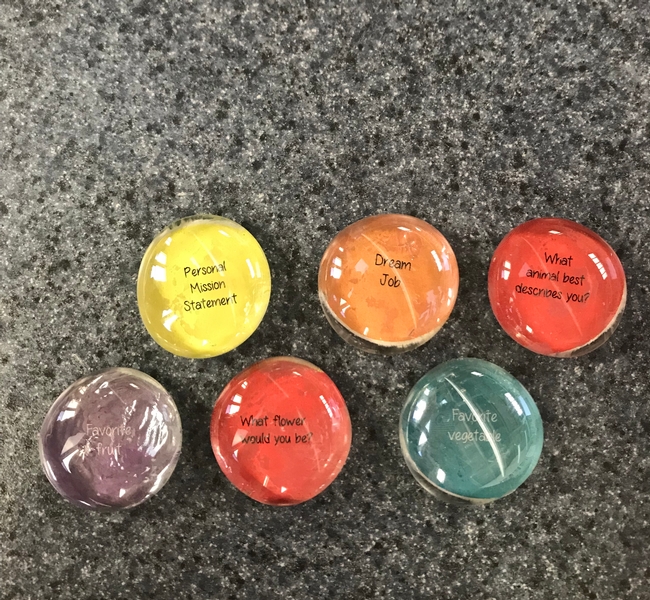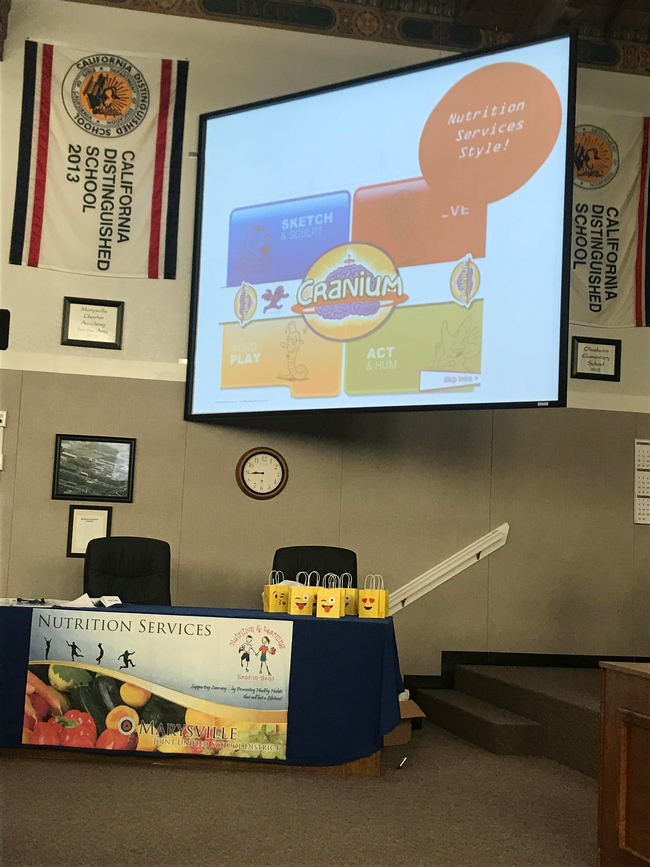Today I had the pleasure of partnering with the Marysville Joint Unified School District (MJUSD) to offer a Nutrition 101 course to all of MJUSD's Nutrition Services employees which includes over 100 individuals consisting of food service managers, front line staff, and MJUSD's Nutrition Services district office staff members.
For more information on MJUSD Nutrition Services, CLICK HERE.
Today's Nutrition 101 course consisted primarily of information from Nutrition 101: A Taste of Food and Fitness Curriculum that was developed by the National Food Service Management Institute (NFSMI). Topics covered in the Nutrition 101 course include; 1) Nutrition is Important to You!, 2) Tools for Guiding Food Choices, 3) Macronutrients: The Energy Nutrients, 4) Micronutrients: Vitamins and Minerals, 5) Special Diets, 6) Putting it All Together, and 7) Nutrition Issues in the Media. For more information about NFSMI's resource, courses and programs, CLICK HERE.
This fun-filled training started off with an exciting ice breaker which involved the use of small conversation starter tokens [pictured below]. Training participants were assigned to a table upon arrival to the training. For this activity, participants were instructed to each take a couple tokens out of a small bag and then go around the table and share their answers. For example, one individual at my table picked a token out of the bag that stated “favorite vegetable”. When it was her turn to share with the group, she stated that her favorite vegetable was a cucumber. This was such a fun activity and a great way to start some dialogue while also learning some fun facts about each other.
While all of the content of today's training was interesting, relevant, and well received by participants, I am just going to highlight two of the main takeaways from the training. The first being the importance of mindful eating (eating with intention and attention). Shannon Pierson, a Dietetic Intern from CSU Chico shared six strategies with the group to help us mindlessly eat better. These six strategies included:
Six Strategies to Mindlessly Eat Better
1. Think 20% - More or Less
a. Dish out 20% less that you think you might want
- Most people can eat 20% less without noticing a difference (still satisfied)
- If you eat 30% less, you will realize it and still want more
b. Eat 20% more fruits and vegetables
c. Try eating until you are just 80% full
- Most Americans stop eating when they feel full
- In some countries, it is mores common to stop when they no longer feel hungry
2. See All That You Eat
a. See it before you eat it
- Pre-plate your food: Most people eat about 14% less than when you take small amount and go back for a 2nd's or 3rd's
- Put everything on a plate or in a bowl before eating
- Avoid eating out of a package or box
b. See it while you eat it
- You'll eat less if you see what you already ate and/or drank
3. Control Your Tablescape – (simple changes to mindlessly eat 15% less)
a. Mini-size your boxes and bowls
- Repackage your jumbo box into smaller containers or Zipoc bags
- Serve in smaller dishes
- The smaller the dish, the less you take and the less you eat
b. Become and illusionist
- Exchange large plates, bowls, and serving bowls/platter for smaller ones
- Exchange short, wide glasses/cups for tall, slender ones
4. Make Overeating a Hassle, Not a Habit
a. Tips to give you a chance to pause and rethink
- Leave serving dishes in the kitchen or on a side table
- At least 6 feet away
- Place salads and veggies in the middle of a table (“pick me” spot)
- “De-convenience” tempting foods
- Relocate to harder-to reach places
- Reseal packages
- Wrap tempting leftovers in aluminum foil
- Snack only at the table and on a clean plate )”de-convenience the action”)
5. Create Distraction-Free Eating Scripts (patterns)
a. Re-script your eating patterns:
- Try to be the last person to start eating
- Pace yourself with the slowest eater at the table
- Avoid the “just one more helping” temptation by always leaving some food on your plate as if you're still eating
b. Distract yourself before you snack
- Distractions can be good when they prevent us from starting to snack
- Distractions can cause mindless eating when they prevent us from stopping
c. If a distraction can't be avoided, serve yourself a portion before you start
6. Make comfort Foods More Comforting
a. Comfort foods make life enjoyable – learn how to have your cake and eat it too.
- Don't deprive yourself
- Diets fail because the deprive us of food and the lifestyle that we enjoy
- Eat what you love in smaller amounts (mindful eating helps!)
b. Rewire your comfort foods
- Pair healthier foods with positive events
- For example: Smaller bowl of ice-cream with strawberries [1]
The second takeaway that I wanted to highlight is the importance of evaluating nutrition news and popular weight loss plans in the media. With new information about nutrition continuously being published in the media, we are often left wondering, is this really news or is it just nonsense? It can be a real challenge to sort the nutrition gems from the junk and we really want to be prepared to be able to identify those that contain nutrition misconceptions. NFSMI has a great handout titled “Ten Tips for Evaluating Nutrition News” which is great for helping make sense out of nutrition news in the media. This tip sheet can be accessed by clicking HERE.
To summarize, there are ten questions to ask yourself when evaluating nutrition news and popular weight loss plans that are highlighted in the media and those ten questions are:
Ten Questions to Ask Yourself When Evaluating Nutrition News
- Is a quick fix promised? Be wary of any information that promises a quick to fix to a problem. Chances are it does not have sound science behind it.
- Are dire warnings given about a food? Rarely does a single food or product cure or cause an illness. Groups with official sounding names may have a political or economic agenda. Check out the credibility of groups or individuals making dire warnings.
- Does it sound too good to be true? If so, the claims probably are. Many factors determine good health. Family history, long term food and activity habits, and other factors are still unknown.
- Does the report give simple findings from a complex study? Most people would be amazed to see the difference between the research and the media reports. Media outlets want short sound bites of information. Researchers usually write with a tone of caution. They limit their findings or call for more research. Headline writers frequently do not see the scientific reports.
- Is a single study used for new advice? Good science requires more than one study to find the same results. After several studies support a finding, new recommendations may be issued. Be cautious of a single study that appears to turn nutrition science on its ear.
- Do credible health organizations agree? When questionable information is publicized, leading health organizations will issue a response. They may state concerns with a study's findings or recommendations. Continue to follow a story in the days after a report. Check with leading health groups. There may be more to the story.
- Is a list of good and bad foods issued? Be skeptical of lists of foods to eat and foods to avoid totally, especially when there seems to be neither rhyme nor reason to the lists.
- Is a product being sold? If a new product is promoted as a cure all to a problem, be cautious. The people behind the information have profit motivation. Be skeptical about new diet books for the same reason. Look at the credentials of the person associated with the product or the book.
- How well was the study conducted? It can be difficult for consumers to determine if a study is valid. Testimonials, one person's story, are not considered solid science. In a testimonial, someone says, “I did this and this happened.” The two events may not be cause and effect. They may be coincidence. Good science is peer reviewed and repeated by other scientists.
- Does the study take results from one group and apply it to others? A study of one group of individuals cannot be applied to another group in the population. The differences between children and adults, women and men, and between subgroups in the population require separate studies. [2,3]
Lastly, I wanted to share another fun activity that was incorporated into today's training as a team building activity. This activity was called Nutrition Cranium. This was yet another great addition to the training that encouraged teamwork. During this activity, table groups participated as teams and individuals had opportunities to sketch, sculpt, act and play.
During Round 1, each table received a small container of PlayDoh and one team member was provided with the instructions to sculpt MyPlate. The only clue that was given to the other team members was “Healthy Choices”. You can see the MyPlate that was sculpted at my table below.
For more information about MyPlate, CLICK HERE.
Overall today was a fun, information filled day and I couldn't be happier to be a partner in health with MJUSD Nutrition Services!
References
- Wansink, Brian. Mindless eating: Why we eat more than we think. Bantam, 2007.
- Nutrition 101: A Taste of Food and Fitness. National Food Service Management Institute. The University of Mississippi, 2018. http://www.theicn.org/ResourceOverview.aspx?ID=90
- Academy of Nutrition and Dietetics Ten Red Flags for Junk Science 2013 Media Guide, January 2013 www.eatright.org 2012-13_Media_Guide-web-jan2013.pdf




